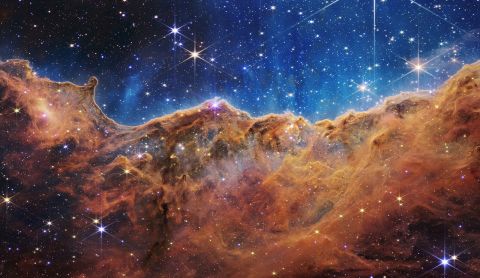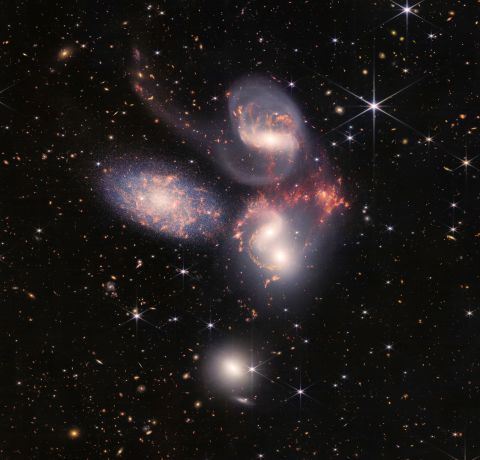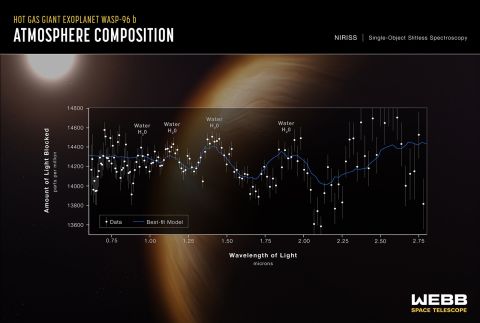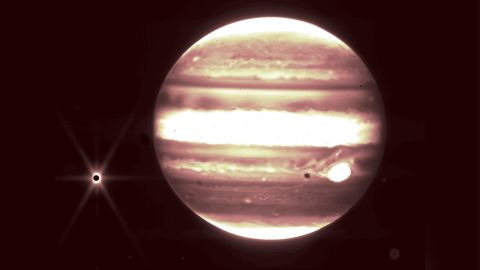
Webb telescope shows off Jupiter in new image

Photos: Observing the universe with the James Webb Space Telescope
NASA/ESA/CSA/STScI
Webb’s landscape-like view, called “Cosmic Cliffs,” is actually the edge of a nearby, young, star-forming region called NGC 3324 in the Carina Nebula. The telescope’s infrared view reveals previously invisible areas of star birth.

Photos: Observing the universe with the James Webb Space Telescope
NASA/ESA/CSA/STScI
The five galaxies of Stephan’s Quintet can be seen here in a new light. This is Webb’s largest image yet, containing over 150 million pixels. These galaxies appear to dance with one another, showcasing how these interactions can drive galactic evolution.

Photos: Observing the universe with the James Webb Space Telescope
NASA/ESA/CSA/STScI
This side-by-side comparison shows observations of the Southern Ring Nebula in near-infrared light, left, and mid-infrared light, right, from NASA’s Webb telescope. The Southern Ring Nebula is 2,000 light-years away from Earth. This large planetary nebula includes an expanding cloud of gas around a dying star, as well as a secondary star earlier on in its evolution.

Photos: Observing the universe with the James Webb Space Telescope
NASA/ESA/CSA/STScI
Webb spied the steamy atmosphere of exoplanet WASP-96 b, located 1,150 light-years away. Webb’s spectrum found a distinct signature of water, along with evidence of clouds and haze. It is the most detailed spectrum of an exoplanet to date.

Photos: Observing the universe with the James Webb Space Telescope
NASA/ESA/CSA/STScI
President Joe Biden released one of Webb’s first images on Monday July 11. The image of SMACS 0723 is “the deepest and sharpest infrared image of the distant universe to date,” according to NASA.
Sign up for CNN’s Wonder Theory science newsletter. Explore the universe with news on fascinating discoveries, scientific advancements and more.
CNN —
The James Webb Space Telescope’s first stunning images of the distant universe have been followed up by something a little closer to home.
Data collected during the telescope’s commissioning period, before its science operations officially started on July 12, have been released on the Space Telescope Science Institute’s website. The publicly available data is now ready for scientists around the world to study.
That data includes new images of Jupiter, which were taken while the space observatory’s instruments were still being tested.
“Combined with the deep field images released the other day, these images of Jupiter demonstrate the full grasp of what Webb can observe, from the faintest, most distant observable galaxies to planets in our own cosmic backyard that you can see with the naked eye from your actual backyard,” said Bryan Holler, a scientist at the Space Telescope Science Institute in Baltimore, in a statement.
Holler helped with the planning for the observations.
Webb is an infrared telescope, so it captures light that is invisible to the human eye. One of Webb’s images of Jupiter shows the giant planet’s telltale atmospheric bands as well as the Great Red Spot.
This famous feature is a massive storm about twice the size of Earth that has churned for over a century. It looks white in the image due to the processing of the infrared image.
Europa, one of Jupiter’s moons, is visible to the left of the planet. The shadow of the moon also makes a cameo left of the Great Red Spot.

“I couldn’t believe that we saw everything so clearly, and how bright they were,” said Stefanie Milam, Webb’s deputy project scientist for planetary science based at NASA’s Goddard Space Flight Center in Greenbelt, Maryland, in a statement.
“It’s really exciting to think of the capability and opportunity that we have for observing these kinds of objects in our solar system.”
Some of the telescope’s other perspectives of Jupiter revealed some of the planet’s faint rings. The images prove that Webb is able to observe faint details and objects close to bright planets like Jupiter and Saturn.
This is especially exciting because it means that Webb may also be able to observe plumes of material releasing into space from ocean worlds in our solar system, like Europa or Saturn’s moon Enceladus.
Interactive: The search for life on Mars and ocean worlds in our solar system
“We’ll look at our own solar system with new infrared eyes, looking for chemical traces of our history, and tracking down mysteries like Jupiter’s Great Red Spot, composition of the ocean under the ice of Europa, and the atmosphere of Saturn’s giant moon Titan,” said John Mather, Webb senior project scientist at NASA Goddard, in a statement.
The first images were anticipated by Mather for 25 years. “What comes next? All the tools are working, better than we hoped and promised. Scientific observations, proposed years ago, are being made as we speak,” Mather said.
“We want to know: Where did we come from? What happened after the big bang to make galaxies and stars and black holes? We have predictions and guesses, but astronomy is an observational science, full of surprises.”
Source: https://www.cnn.com/2022/07/18/world/webb-telescope-jupiter-images-scn/index.html















